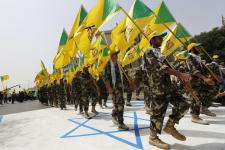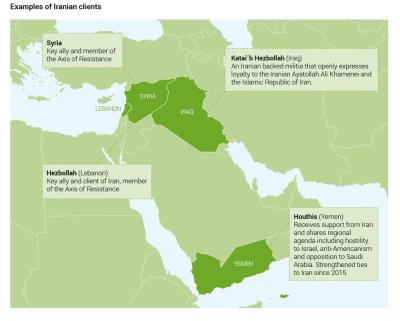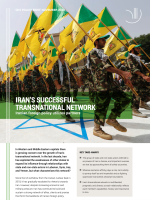Iran's successful transnational network: Iranian foreign policy utilizes partners

- The group of state and non-state actors referred to as proxies of Iran is diverse, and important nuances are lost by approaching them all solely as proxies.
- Whereas sectarian affinity plays a role, Iran’s ability to portray itself as anti-imperialist and as fighting oppression transcends sectarian boundaries.
- Iran’s transnational network is multifaceted, pragmatic and diverse, as each relationship reflects each member’s capabilities, history and importance to Iran.
Since the US withdrew from the Iranian nuclear deal in 2018, it has gradually escalated its rhetoric towards Iran. However, despite increasing economic and military pressure, Iran has continued to build and sustain a strong network of allies, clients and proxies that form the backbone of Iranian foreign policy.
Whereas the most loyal of these clients are Twelver Shias that share Iran’s theocratic system, Iran has been able to appeal to non-Shia groups, most notably Hamas.
Whereas Iran’s foreign policy draws on core Shia themes, Iran frames itself as anti-imperialist and as fighting oppression for all. Importantly, opposition to Israel and the USA can transcend sectarian boundaries.
Iran’s successful transnational network
Iran’s success in building relationships and retaining the loyalty of its clients is relative and not uniform. Proxies are actors that depend on obtaining outside resources from Iran, and as a result they are loyal to Iran both domestically and regionally. First, as Iran has limited resources, Iranian client relationships are strongest when the client has limited access to alternative external funding, making Iran the unrivalled patron.
Second, and relatedly, clients cannot effectively further a domestic agenda if they do not have some internal legitimacy and support. Iran has been pragmatic and flexible in seeking out groups with domestic agendas that are aligned with Iranian goals and in building personal and organizational ties beyond the simple transfer of resources.
Third, for an actual proxy relationship to exist, the client must not only share Iran’s regional agenda, but also support its agenda for domestic politics. Whereas a large group of state and non-state actors share Iran’s regional goals, including opposition to Israel and staunch anti-Americanism, they are not necessarily proxies, though they might be allies or something in between. There is great variation in Iran’s relationships with its clients, based on their respective capabilities, histories and importance to Iran, but Iran skilfully portrays itself as the core and centre of a loyal network.
Growing Iranian influence in the Middle East
Since the Iranian revolution of 1979, Iran has worked to build its transnational network to further its strategic political aims and support Shia minorities in the region. Consequently, it has created long-standing relationships with a variety of actors, which it has used to increase its influence in states that have been weakened since the Arab Uprisings. An example of this was Iran’s ability to respond quickly to the threat from Islamic State in Iraq. Iran channelled support to Shia groups and individuals with whom relations had been established and developed during the rule of Saddam Hussein.
The advance of IS in Iraq, as an extremist Sunni group targeting Iraqi Shia, tapped into a broader narrative of Shia persecution in the region. However, whereas Iranian support focuses mainly on fellow Shia, it also offers aid to all those it deems to be oppressed by the current U.S.-dominated world order in the Middle East and beyond. This is epitomized in the idea of the Axis of Resistance, whose core members are Iran, Hezbollah and Syria, and who share the struggle against Israel, the US and their allies, including Saudi Arabia.
Kata’ib Hezbollah: an Iranian proxy in Iraq
Iran’s influence has grown in Iraq since 2014 due to the collapse of the Iraqi security services, which gave the militias, the so-called Popular Mobilization Forces (PMF) or Hashd al-Shabi, a key role in the fight against IS.

The PMF are made up of approximately fifty militias, including non-Shia and Shia groups who are not loyal to Iran. However, the strongest groups are Shia with ties to Iran such as the Badr Organization, Aṣaʾib ʾAhl al-Haqq (AAH) and Katai’b Hezbollah (KH). KH is an Iranian-backed Shia PMF oriented towards the Iranian Ayatollah Ali Khamenei.
KH has played a key role in the escalation of tensions between Iran and the US since late 2019. When, on 3 January 2020, a US drone strike killed General Qassim Soleimani, head of Iran's Islamic Revolutionary Guard Corps' (IRGC's) Quds Force, while he was on route from Baghdad Airport, the senior commander of the Iraqi PMF and head of Kata’ib Hezbollah, Abu Mahdi al-Muhandis, was killed alongside him. The double assassination of Soleimani and Muhandis underscores the close relationship between the IRCG and KH. The group has grown in influence and manpower, from approximately four hundred active members in 2009 to an estimated ten thousand currently, due to Iran’s support and its role in countering the threat from Islamic State.
KH publicly supports the Shia notion of guardianship (Wilāyat al-Faqīh) and points to the establishment of the Islamic Republic of Iran as a key phase in the preparations for Islamic governance. As such, KH members accept Iran's Ayatollah Ali Khamenei as their spiritual leader, instead of the Iraqi Ayatollah, Ali al-Sistani. Simultaneously, the group is vehemently anti-American and openly advocates armed ‘resistance’ to the continued US military presence in Iraq. In 2009 the US designated KH a terrorist organization based on its history of targeting US interests. Hence, KH would qualify as a proxy of Iran.
The Houthis: overlapping regional goals
Another example of Iran’s growing transnational network since the Arab Uprisings is its relationship with the Houthis in Yemen, led by Abdul Malek Al-Houthi. When the Houthis took control of the Yemeni capital, Sana’a, in September 2014, and events escalated further with the Saudi-led military intervention against the Houthis from March 2015, the relationship was solidified. Whereas the degree of linkage remains disputed, there is no doubt that the Houthis and Iran have strengthened their ties.
Although Iranian support is relatively limited, its importance to the Houthis is underscored by the fact that the latter do not have any alternative patrons. Whereas the Houthis are often described as Shia and therefore as a ‘natural’ proxy to Iran, this is only partially true, as the Houthis are Zaydi, a branch of Shiism that distinguishes itself from the Twelver Shiism found in Iran. Hence, despite more public relations and open support for the Houthis from Iran's Ayatollah Ali Khamenei, the rise of the Houthis cannot be explained with reference to Iranian support but is a consequence of historical and political events within Yemen itself.
Instead, what has brought the Houthis and Iran together is their shared regional agenda, which focuses on countering Israel and the USA. The Houthis see themselves as being under attack from Saudi Arabia and thus as being well within their rights to launch counterattacks. Strikes on Saudi Arabia can even be used to build their internal legitimacy, as anti-US and anti-Saudi sentiments are widespread in Houthi-controlled areas.
As such, the Houthis have become a low-cost investment for Iran that causes Saudi Arabia considerable headaches. Moreover, since from the Iranian perspective Yemen’s strategic importance stems primarily from its geostrategic position and importance to Saudi Arabia, Iran has taken a pragmatic approach to internal Yemeni affairs.
The future for Iran’s network of proxies
Iran has been able to grow its influence in the region, but for now this expansion seems to have slowed. In Lebanon and Iraq, protesters openly challenged Iran’s influence until a combination of protest fatigue, Soleimani’s assassination and COVID-19 limited large-scale protests. However, the discontent with Iranian interference remains.
In Iraq in May 2020, the former Iraqi intelligence chief, Mustafa al-Kadhimi, became Iraq’s transitional prime minister, despite opposition from Kata’ib Hezbollah. He has sworn to limit the political influence of the PMFs and has revitalized attempts to integrate the PMFs into the Iraqi state. In April 2020, four units, referred to as the ‘shrine units’ and considered closer to Sistani, publicly decided to move out from under the PMF umbrella, while Sistani distanced himself more openly from the Iranian-aligned PMFs.
This may weaken the Iranian-backed PMFs, including their political wings. Whereas the US strategy of ‘maximum pressure’ is limiting Iran’s financial capabilities, it remains to be seen whether this will negatively affect Iran’s relationships with its actual proxies. As these relationships have never just been instrumental relationships based on the size of Iran’s coffers, it is not a given.
DIIS Experts


